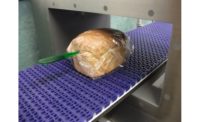When it comes to metal detectors, bakery and snack food producers are looking for increased sensitivity, lower false rejects, food-safe materials, fail-safe operation and systems that are protected from operator error or misuse. They also are demanding data-logging functions that provide system information and validation of performance levels, as well as networking capabilities. Manufacturers are answering the call with technological innovations.
As consumers, retailers and foodservice operations continue to become more concerned about the safety of food products, bakery and snack food manufacturers are working to improve their quality-control and inspection programs. Foreign object detection, x-ray inspection and sophisticated metal detectors that were once primarily used for prepared foods are now becoming standards in bakeries and snack food plants.
Manufacturers continue to tighten their sensitivity requirements to assure the highest level of food safety, says Bob Ries, lead product manager, metal detection and x-ray inspection, at Thermo Fisher Scientific, Minneapolis. “As part of this effort, we have seen some companies expand their metal-detection requirements to make sure their systems are fail-safe and protected from operator error whenever possible,” he explains.
New systems incorporate features such as reject/verify, bin-full, timing rejection and multilevel passwords—many of which were originally developed for pharmaceutical applications. “Bakery and snack food producers are starting to realize that they may not be using best practices and are expanding their metal-detection requirements to include these features,” Ries notes.
Addressing static challenges
Manufacturers of metal-detection equipment face challenges when designing equipment for bakery and snack food plants. “Snack and bakery dry-material-handling operations can create static that affects metal-detector operation, so it’s important to consider the presence of static and incorporate the use of static-free chute and slider-bed materials,” says David C. Smith, sales manager, Advanced Detection Systems, Milwaukee. His company recently introduced the ProScan Max, which is designed to enhance metal detection levels for dry products in conveyor and gravity-fed applications.
In some cases, metal-detection equipment may be located close to an oven, so it must be able to tolerate extremely high temperatures.
Also, more snack foods are being packaged in metalized film. In these cases, experts recommend migrating from metal detection to x-ray equipment. However, x-ray equipment is usually more expensive, so manufacturers need to verify price and performance justifications before moving forward.
Many companies today want to capture data from their metal-detection systems and therefore request features such as USB ports, Ethernet and data-management software as well as other forms of data capture, according to Geri Foley, metal detection sales manager, at Mettler-Toledo Product Inspection, Tampa, Fla. These features allow a plant to operate more efficiently, as the data is stored safely in its computer for easy retrieval.
Data-logging and networking features are being used by a growing number of companies. “Data-logging functions provide information regarding confirmation of the metal detector’s use and validation of its performance level,” adds Smith. “Networking features are being used to assist food production plants with operation, training and troubleshooting from remote locations.”
Of course, gaining the most benefit from sensitive metal-detection equipment requires an understanding of system components and operating principles. To provide guidance on optimal metal-detection system design and operation, Mettler-Toledo has published a white paper titled “Foreign Body Detection: Metal.” It addresses the selection, installation and use of metal detection equipment to optimize system performance, including how to assure sensitivity on an ongoing basis.
Factors that help ensure production-line system effectiveness include ease of setup, mitigation of drift/erratic detection and elimination of false rejects without constant attention to maintain sensitivity standards. “Critical elements such as balance stability/vibration immunity and reject mechanism design must be considered to provide reliable detection,” according to the white paper.
“When they are, a metal-detection system can help manufacturers prove due diligence and meet an expanding series of retail-driven practice codes while keeping customers happy with the finished products.”
Thermo Fisher Scientific recently introduced the APEX HD (heavy-duty) metal detector, which reportedly is designed to survive 10 years of hot-water cleaning with no degradation in performance or water ingress. It’s available for conveyor, pipeline and gravity applications. “The system was developed to solve a long-standing metal detector problem,” Ries explains. “When a cold metal detector is repeatedly exposed to hot water, the aperture lining eventually cracks, which allows water to seep inside. The APEX HD can avoid this premature failure, saving the customer from expensive downtime and repairs.”
Mettler-Toledo recently introduced the PRO metal detector along with data-management software. “A principal cause of metal-contaminated products reaching the consumer is procedural failure, such as the inadvertent replacement of rejected products on the production line after inspection, rather than metal detector failure,” says Foley. “The PRO metal detector ensures that contaminated packs are properly removed from the line and remain secure until accessed by authorized personnel. This feature, coupled with our ProdX data-management software, translates into less reliance on line operators for data entry and reduces instances of human error, keeping production line data secure.”
ProdX is a connectivity software program that allows centralized monitoring, control and data documentation for checkweighers, metal detectors and x-ray systems, whether operating in one location or in multiple facilities. Multiple product-inspection devices can be integrated into a central monitoring system, which can be monitored from multiple locations.
Downsizing contaminants
Increased emphasis on food safety has bakery and snack food producers seeking detection of ever-smaller contaminant sizes, says Todd Grube, manager of inspection systems, Heat and Control Inc., Hayward, Calif. The latest metal-detection technology makes it possible for producers to choose the most economical detection solution depending on their product. Heat and Control offers the CEIA line of metal detection equipment.
For neutral products, such as potato chips, detectors using a single high-frequency provide superior and cost-effective metal
detection, according to the company. However, the higher the frequency, the more likely errors will occur caused by environmental interference or noise produced by electric motors commonly used in many food plants. “CEIA’s THS/G21 metal detectors negate this type of interference, which reduces false rejects while offering high sensitivity to metal contaminants,” Grube explains.
For foods producing a product effect signal, a wide range of frequencies is needed to mask the product effect as well as environmental interference, without reducing sensitivity to metal contaminants. “CEIA has developed a new technology to accomplish this: The THS/MS21 Multi-Spectrum metal detector,” Grube explains. “Using a spectrum of multiple frequencies simultaneously, the MS21 eliminates false rejects without reducing metal-detection sensitivity.”
Global packaging solutions provider tna has developed the hyper-detect metal detector, which reportedly allows faster packing speeds. Conventional “throat” metal detectors have been used in the food industry to inspect product before it enters the bag to allow the use of metallized film. The integrated design of the hyper-detect allows the metal detector to be positioned much closer to the multi-head weigher, dramatically increasing the speed at which the bagger can produce finished bags.
“With a high-frequency function, the hyper-detect provides stable operation for optimum sensitivity and consistent performance when inspecting products,” tna reports. “Able to detect ferrous contaminants from 0.8-0.9 mm, nonferrous pieces up to 1.0 mm and nonmagnetic stainless steel from 1.0-1.2 mm, the hyper-detect is extremely sensitive, which reduces the risk of contaminants entering the value chain.”
Loma Systems, Carol Stream, Ill., has introduced the Loma IQ3 metal detector, featuring variable-frequency technology, which allows operators to auto-select the correct frequency for maximum contaminant sensitivity. The system’s electronics reportedly enable its Automatic Product Learn system to calibrate and automatically learn the characteristics and settings for up to 100 different products. In addition, the machine is designed for tough washdown cleaning specification and meets the IP69K environment standard.
“The unit includes a performance validation system, which automatically prompts the operator to test performance at pre-set intervals, according to HACCP (Hazard Analysis Critical Control Point) principles,” the company reports. “This produces a detailed record of any contaminants found, leaving a detailed audit trail, which is crucial to meet BRC standards.”
Cognex, Natick, Mass., has released a new version of its In-Sight Explorer software, which includes a surface-flaw tool and scene-correction filter designed to improve metal detection. The system simplifies the detection of surface defects such as scratches, discoloration, burn/black spots, label wrinkles, small dents, tears or pinholes. The scene-correction filter balances images with uneven illumination to help present the defect-detection tools with evenly lit images.
In-Sight Explorer software offers bakery and snack food producers a suite of inspection tools that reduces costs and helps protect brand image. “The surface-flaw tool and scene-correction filter ease the setup of applications that inspect for defects on a part or a product surface,” says Herb Lade, Cognex vice president and business unit manager of vision systems.
Whether bakers and snack manufacturers need to find the tiniest contaminant or a cost-effective way to ensure that all their products are safe, they’ll be able to find a metal-detection system today that fits their needs.












